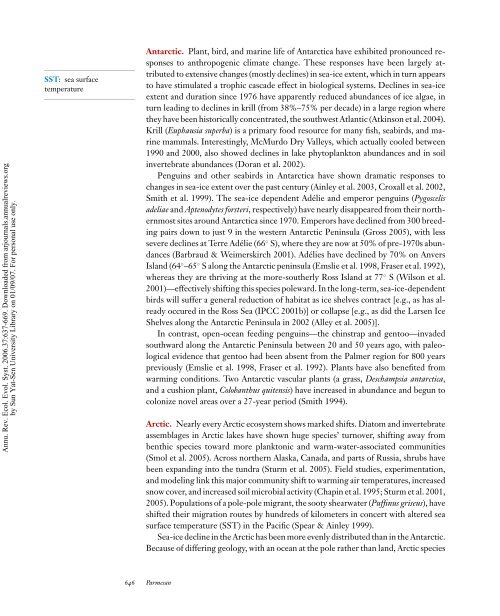Ecological and Evolutionary Responses to Recent Climate Change
Ecological and Evolutionary Responses to Recent Climate Change
Ecological and Evolutionary Responses to Recent Climate Change
You also want an ePaper? Increase the reach of your titles
YUMPU automatically turns print PDFs into web optimized ePapers that Google loves.
Annu. Rev. Ecol. Evol. Syst. 2006.37:637-669. Downloaded from arjournals.annualreviews.org<br />
by Sun Yat-Sen University Library on 01/09/07. For personal use only.<br />
SST: sea surface<br />
temperature<br />
Antarctic. Plant, bird, <strong>and</strong> marine life of Antarctica have exhibited pronounced responses<br />
<strong>to</strong> anthropogenic climate change. These responses have been largely attributed<br />
<strong>to</strong> extensive changes (mostly declines) in sea-ice extent, which in turn appears<br />
<strong>to</strong> have stimulated a trophic cascade effect in biological systems. Declines in sea-ice<br />
extent <strong>and</strong> duration since 1976 have apparently reduced abundances of ice algae, in<br />
turn leading <strong>to</strong> declines in krill (from 38%–75% per decade) in a large region where<br />
they have been his<strong>to</strong>rically concentrated, the southwest Atlantic (Atkinson et al. 2004).<br />
Krill (Euphausia superba) is a primary food resource for many fish, seabirds, <strong>and</strong> marine<br />
mammals. Interestingly, McMurdo Dry Valleys, which actually cooled between<br />
1990 <strong>and</strong> 2000, also showed declines in lake phy<strong>to</strong>plank<strong>to</strong>n abundances <strong>and</strong> in soil<br />
invertebrate abundances (Doran et al. 2002).<br />
Penguins <strong>and</strong> other seabirds in Antarctica have shown dramatic responses <strong>to</strong><br />
changes in sea-ice extent over the past century (Ainley et al. 2003, Croxall et al. 2002,<br />
Smith et al. 1999). The sea-ice dependent Adélie <strong>and</strong> emperor penguins (Pygoscelis<br />
adeliae <strong>and</strong> Aptenodytes forsteri, respectively) have nearly disappeared from their northernmost<br />
sites around Antarctica since 1970. Emperors have declined from 300 breeding<br />
pairs down <strong>to</strong> just 9 in the western Antarctic Peninsula (Gross 2005), with less<br />
severe declines at Terre Adélie (66 ◦ S), where they are now at 50% of pre-1970s abundances<br />
(Barbraud & Weimerskirch 2001). Adélies have declined by 70% on Anvers<br />
Isl<strong>and</strong> (64 ◦ –65 ◦ S along the Antarctic peninsula (Emslie et al. 1998, Fraser et al. 1992),<br />
whereas they are thriving at the more-southerly Ross Isl<strong>and</strong> at 77 ◦ S (Wilson et al.<br />
2001)—effectively shifting this species poleward. In the long-term, sea-ice-dependent<br />
birds will suffer a general reduction of habitat as ice shelves contract [e.g., as has already<br />
occured in the Ross Sea (IPCC 2001b)] or collapse [e.g., as did the Larsen Ice<br />
Shelves along the Antarctic Peninsula in 2002 (Alley et al. 2005)].<br />
In contrast, open-ocean feeding penguins—the chinstrap <strong>and</strong> gen<strong>to</strong>o—invaded<br />
southward along the Antarctic Peninsula between 20 <strong>and</strong> 50 years ago, with paleological<br />
evidence that gen<strong>to</strong>o had been absent from the Palmer region for 800 years<br />
previously (Emslie et al. 1998, Fraser et al. 1992). Plants have also benefited from<br />
warming conditions. Two Antarctic vascular plants (a grass, Deschampsia antarctica,<br />
<strong>and</strong> a cushion plant, Colobanthus quitensis) have increased in abundance <strong>and</strong> begun <strong>to</strong><br />
colonize novel areas over a 27-year period (Smith 1994).<br />
Arctic. Nearly every Arctic ecosystem shows marked shifts. Dia<strong>to</strong>m <strong>and</strong> invertebrate<br />
assemblages in Arctic lakes have shown huge species’ turnover, shifting away from<br />
benthic species <strong>to</strong>ward more plank<strong>to</strong>nic <strong>and</strong> warm-water-associated communities<br />
(Smol et al. 2005). Across northern Alaska, Canada, <strong>and</strong> parts of Russia, shrubs have<br />
been exp<strong>and</strong>ing in<strong>to</strong> the tundra (Sturm et al. 2005). Field studies, experimentation,<br />
<strong>and</strong> modeling link this major community shift <strong>to</strong> warming air temperatures, increased<br />
snow cover, <strong>and</strong> increased soil microbial activity (Chapin et al. 1995; Sturm et al. 2001,<br />
2005). Populations of a pole-pole migrant, the sooty shearwater (Puffinus griseus), have<br />
shifted their migration routes by hundreds of kilometers in concert with altered sea<br />
surface temperature (SST) in the Pacific (Spear & Ainley 1999).<br />
Sea-ice decline in the Arctic has been more evenly distributed than in the Antarctic.<br />
Because of differing geology, with an ocean at the pole rather than l<strong>and</strong>, Arctic species<br />
646 Parmesan
















